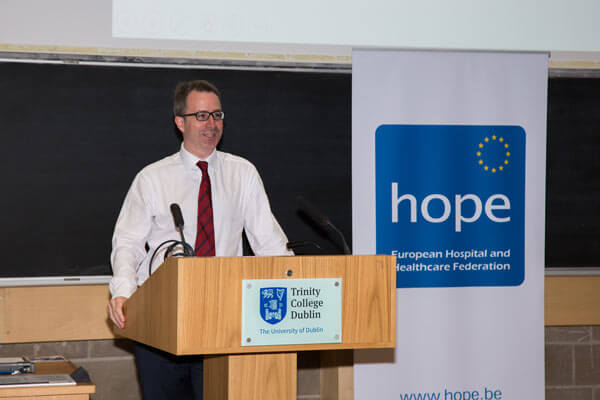A major shift in our model of health and social care, with new policies, programmes and practices, were necessary to tackle Ireland’s changing demographics and increasing chronic illness, Mr. Jim Breslin, Secretary General, Department of Health told the AGORA.

This was necessary because of increasing life expectancy, decreased mortality from certain diseases and increased survival rates from others on the one hand and risk factors, such as smoking, obesity and lack of physical exercise on the other hand.
Speaking on Innovations in Irish hospitals and healthcare, Mr. Breslin said in 2013, life expectancy in Ireland for women at 83 years was on a par with the EU and for men at 79 years was above the EU figure.
Ireland’s over 65 population was set to increase by over 24% between 2013 and 2021, and increasing numbers were requiring emergency hospital admission.
In 2010, 76% of deaths in Ireland were due to three major conditions – cardiovascular disease (34%), cancer (30%) and respiratory disease (12%).
Approximately 38% of Irish people aged 50 and over had a chronic disease and 11% had more than one.
Breslin said the main risk factors in Ireland today were lack of physical activity, obesity, smoking and alcohol.
As the number of older people increased this burden of chronic disease would grow, – HSE estimated by 20% by 2020.
Between 2005 and 2014, Irish mortality rates dropped by 31.5% for circulatory system diseases, 7.9% for cancers, 20% for respiratory system diseases, 4.2% for infant mortality and20.7% from external causes.
Between the periods 1998-2003 and 2008-2013, the five year survival rate for breast cancer was up from 75.8% to 81.5% and for colorectal cancer it was up from 51% to 60.3%. Cases of Meningitis C were down from 130 cases in 1999 to six in 2014.
Estimates projected a 70% increase in cancer cases in females and an 83% increase in males between 2015-2040.
In 2011, 40% of all hospitalisations in patients over 35 years related to four chronic diseases; cardiovascular disease, cancer, respiratory disease and diabetes (either as a direct reason for hospitalisation 19%, or a contributory factor 22%). Chronic disease accounted for 80% of all GP visits.
Seventy six per cent of all bed days used, either directly (46%) or as a contributory factor (30%) were by patients with these four conditions.
Fifty five per cent (€1.68 billion) of acute hospital budget was attributable to care of patients with these conditions, either directly or indirectly
Mr. Breslin said the main risk factors in Ireland today were lack of physical activity (Only 32% of people were sufficiently active), obesity (60% of people were overweight or obese), smoking (19% smoked on a daily basis) and alcohol (41% of drinkers binge drank at least once a month).
Between 2006 and 2014, there had been a 54% increase in day case procedures – up from 558,813 to 860,763 – while the number of inpatient procedures remained constant – at approx 600,000 per year.
Ireland was addressing these risk factors – smoking among adults was down from 33% to 23% and among children from 21% to 8% between 1998 and 2014.
The Secretary General said Ireland’s health services were changing to meet changing needs. Between 2006 and 2014, there had been a 54% increase in day case procedures – up from 558,813 to 860,763 – while the number of inpatient procedures remained constant – at approx 600,000 per year.
Between 2008 to 2014, the cost per weighted unit of care fell by 19% (inpatient) and 18.7% (day case), while the day of surgery admission rate increased by 9%.
The HSE Integrated Care Programme for prevention and management of chronic disease provided for integration as a fundamental principle of design rather than a system of delivery as a response to long term, complex care.
It was community delivered but integrated across all agencies and services. It also provided for population stratification of risk (and case finding), anticipatory Care Planning (based on common assessment) and care co-ordination by a case manager (with agreed care pathways).
Mr. Breslin said that good quality primary care could help prevent the need for hospital admission; there were well established treatment guidelines for chronic conditions.
However there were significant differences between Ireland and other countries and between counties in Ireland. We would never eliminate need for hospital treatment but there was potential to significantly improve hospitalisation rates and the standard of care for these conditions.
Reflecting on what this might mean, the Secretary General said it would mean:
- A national focus on population directed disease prevention and health promotion covering physical and mental health.
- A greater focus on population health and demographics in planning and delivering services.
- Support for self-care and primary care based strategies.
- Social care policy and service development to provide greater clarity on financing, entitlements, regulation and choice to support independence.
- Linkage between providers through greater shared care across organisational boundaries.
- Multidisciplinary teams used to provide care.
- Supportive clinical decision systems.
- Outcomes-based monitoring and evaluation framework.

